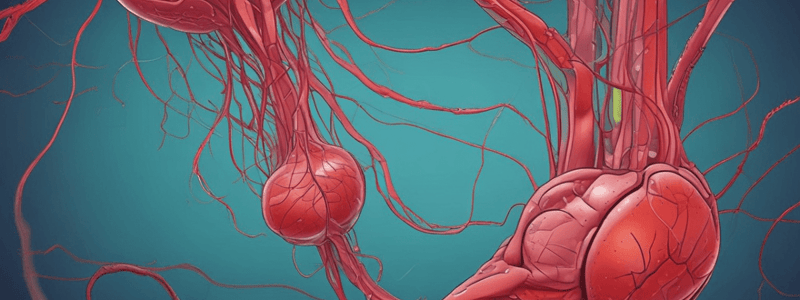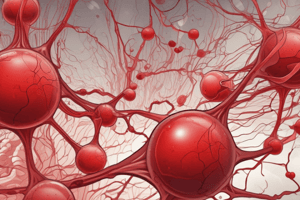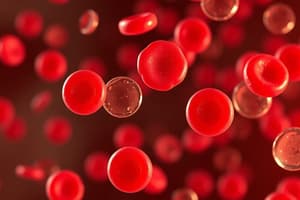Podcast
Questions and Answers
What is the main difference between positive and negative blood types?
What is the main difference between positive and negative blood types?
- Higher platelet count in positive blood types
- Presence of Rh protein in positive blood types (correct)
- Lack of antibodies in negative blood types
- Absence of leukocytes in negative blood types
Which leukocyte type is known for being phagocytic specialists and going through NETosis to kill nearby bacteria?
Which leukocyte type is known for being phagocytic specialists and going through NETosis to kill nearby bacteria?
- Basophils
- Monocytes
- Eosinophils
- Neutrophils (correct)
What is the main function of eosinophils in the immune system?
What is the main function of eosinophils in the immune system?
- Attach to cells and secrete substances to kill them during allergic reaction (correct)
- Directly destroy target cells
- Produce antibodies
- Kill bacteria using NETosis
Which blood cell type synthesizes and stores histamines and heparin?
Which blood cell type synthesizes and stores histamines and heparin?
What is the main role of lymphocytes in the immune system?
What is the main role of lymphocytes in the immune system?
Which cell fragments are shed from megakaryocytes to help in blood clotting?
Which cell fragments are shed from megakaryocytes to help in blood clotting?
What happens during NETosis in neutrophils?
What happens during NETosis in neutrophils?
What are B and T lymphocytes responsible for in the immune response?
What are B and T lymphocytes responsible for in the immune response?
What is the role of thrombopoietin in the process of platelet production?
What is the role of thrombopoietin in the process of platelet production?
Which plasma protein adheres to exposed collagen to initiate clot formation?
Which plasma protein adheres to exposed collagen to initiate clot formation?
What catalyzes the conversion of fibrinogen into fibrin during clot formation?
What catalyzes the conversion of fibrinogen into fibrin during clot formation?
What strengthens and stabilizes the meshwork of fibrin in clot formation?
What strengthens and stabilizes the meshwork of fibrin in clot formation?
Which enzyme is responsible for dissolving the clot?
Which enzyme is responsible for dissolving the clot?
What happens during clot retraction in the process of hemostasis?
What happens during clot retraction in the process of hemostasis?
What role does factor X play in the coagulation cascade?
What role does factor X play in the coagulation cascade?
What is the precursor of plasmin that is responsible for dissolving clots?
What is the precursor of plasmin that is responsible for dissolving clots?
What is the primary stimulus for promoting erythropoiesis?
What is the primary stimulus for promoting erythropoiesis?
What is the main cause of renal anaemia?
What is the main cause of renal anaemia?
Which type of anaemia is characterized by an excess of erythrocytes?
Which type of anaemia is characterized by an excess of erythrocytes?
What happens when a person with blood type O receives a blood transfusion of blood type A?
What happens when a person with blood type O receives a blood transfusion of blood type A?
Which blood type can be transfused into people with any blood type?
Which blood type can be transfused into people with any blood type?
What is the main characteristic of sickle cell disease?
What is the main characteristic of sickle cell disease?
What happens when Rh-positive blood is transfused into an Rh-negative individual?
What happens when Rh-positive blood is transfused into an Rh-negative individual?
What distinguishes ABO blood types from each other?
What distinguishes ABO blood types from each other?
Which organ is responsible for secreting erythropoietin to stimulate erythropoiesis?
Which organ is responsible for secreting erythropoietin to stimulate erythropoiesis?
What enzyme converts CO2 into HCO3- for transport in erythrocytes?
What enzyme converts CO2 into HCO3- for transport in erythrocytes?
Which type of cells are responsible for the removal of old erythrocytes in the body?
Which type of cells are responsible for the removal of old erythrocytes in the body?
What component of plasma contributes to colloid osmotic pressure?
What component of plasma contributes to colloid osmotic pressure?
Which stem cell gives rise to erythroblasts during the development of erythrocytes?
Which stem cell gives rise to erythroblasts during the development of erythrocytes?
Which substance is essential for the formation of a fibrin meshwork in clots?
Which substance is essential for the formation of a fibrin meshwork in clots?
What hormone controls the magnitude of erythropoiesis by regulating erythropoietin release?
What hormone controls the magnitude of erythropoiesis by regulating erythropoietin release?
What is the term used for a free-floating clot?
What is the term used for a free-floating clot?
In which condition is excessive bleeding observed due to a deficiency in clotting factors?
In which condition is excessive bleeding observed due to a deficiency in clotting factors?
What factor determines the flow of blood through a vessel?
What factor determines the flow of blood through a vessel?
What is the term used to describe the friction between fluid molecules as they slide over each other?
What is the term used to describe the friction between fluid molecules as they slide over each other?
Which term describes the condition where there is an excess of red blood cells in the circulation?
Which term describes the condition where there is an excess of red blood cells in the circulation?
What causes a decrease in blood flow through a vessel as mentioned in the text?
What causes a decrease in blood flow through a vessel as mentioned in the text?
Which condition results from an insufficient number of red blood cells or hemoglobin?
Which condition results from an insufficient number of red blood cells or hemoglobin?
What is the process called in which neutrophils release neutrophil extracellular traps to kill nearby bacteria?
What is the process called in which neutrophils release neutrophil extracellular traps to kill nearby bacteria?
What is the main function of eosinophils in the immune system?
What is the main function of eosinophils in the immune system?
What do basophils and mast cells synthesize and store that play a role in inflammatory responses?
What do basophils and mast cells synthesize and store that play a role in inflammatory responses?
What do monocytes develop into as they continue to mature?
What do monocytes develop into as they continue to mature?
Which cells are responsible for shedding cell fragments known as platelets or thrombocytes?
Which cells are responsible for shedding cell fragments known as platelets or thrombocytes?
What is the term for the process of stopping bleeding through blood clot formation?
What is the term for the process of stopping bleeding through blood clot formation?
What is the name of the precursor molecule that is responsible for dissolving clots in the body?
What is the name of the precursor molecule that is responsible for dissolving clots in the body?
Which factor plays a crucial role in the coagulation cascade by activating prothrombin to thrombin?
Which factor plays a crucial role in the coagulation cascade by activating prothrombin to thrombin?
What hormone regulates the production of platelets by stimulating the proliferation of megakaryocytes?
What hormone regulates the production of platelets by stimulating the proliferation of megakaryocytes?
What is the term for the fibres made of chromatin and antimicrobial proteins released by neutrophils during NETosis?
What is the term for the fibres made of chromatin and antimicrobial proteins released by neutrophils during NETosis?
Basophils synthesize and store histamines and insulin.
Basophils synthesize and store histamines and insulin.
During NETosis, neutrophils release neutrophil extracellular traps to kill nearby bacteria.
During NETosis, neutrophils release neutrophil extracellular traps to kill nearby bacteria.
Platelets are responsible for secreting antibodies in the immune system.
Platelets are responsible for secreting antibodies in the immune system.
Monocytes become professional phagocytes as they mature.
Monocytes become professional phagocytes as they mature.
Lymphocytes directly destroy target cells in the immune system.
Lymphocytes directly destroy target cells in the immune system.
Flashcards are hidden until you start studying




